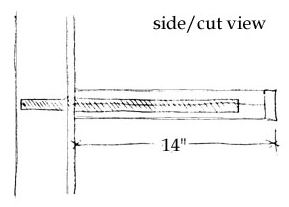Question
We need to build some paint grade, interior pocket doors 3'3" x 96" x 2 1/4". Some have single MDF panels, some have single glass panels, and some have multiple lites. The rails and stiles are 5 1/2" wide.
The client wants "real wood". I've looked into Structural Composite Lumber, balsa and pine block core, and poplar stave cores. The cores are typically edged with 11/16" solid and face veneered with 1/8" solid. This gets more wood in the door, makes the joinery easier for us, and yields a nice heavy door. However, the industry standard that I've had repeated to me by several manufacturers seems to be that the tolerance for deflection is 1/8" in any seven foot section with no warranty for straightness above 7'0". Many said that they don't even expect that much but it is allowable. Of course that's not bad but the contractor and the designer wants them flatter.
Enter Pplascore, polyethylene honeycomb core. We build the rails and stiles by making 11/16" solid frames 1 3/4" thick, fill them with the honeycomb core and vacuum press them with 1/4" MDF faces. Based on what I've been told these should come out of the press straight and stay that way. We would press them in a flip top frame press which is out less than 1/64" over 10'.
But the designer still wants wood under the paint so here's my question. If we build stiles with the frame/core/MDF faces as I described and then veneer them again with 1/8" poplar are we risking much movement. I know that itís probably impossible to do more than speculate about this because of the number of variables involved but if someone can tell me "don't do it!" that would be equally helpful. If I have a reason to push the designer to allow the doors to move a bit then that's fine with me. The price of the Plascore is approx. $2.35/sf in the 2" thickness.
Forum Responses
(Architectural Woodworking Forum)
From contributor D:
1/8" is a bit thick to bond to a stable core. At some point, depending upon the variation in humidity and cycling of same, the veneer will start to act like wood and want to move. Itís likely to expand first, then contract, since it is 6-8% coming in the door, then 8-10% in final environment. If locked into position while expanding, then inevitable shrinkage will open splits unless you have a very stable environment.
Not your question, but there is nothing wrong with solid wood. Buy good poplar from the Midwest, insure it is from a good source/dealer, and work with it. I have experience with thousands of poplar doors - many up to 8' - and have had two poplar doors warp in 35 years.
The 2-1/4" will work for you - laminate for a three ply thickness. If you do not have experience working solid woods, (big joiner, mortise and tenon joinery, etc.) then you may want to sub it to a shop experienced with doors. It is not rocket science, but is not to be taken lightly. There is no reason to have any warp in a wood door - the 1/8" or 1/4" you see every where is just CYA. The rest of the warranty will void any real claims anyway.
On a side note typically polyethylene doesn't stick well to PVA glues. Look at the bottles they come in. There are other honeycomb cores out there like verticel, which is basically a paper honeycomb saturated with epoxy, and what the Gougeon brothers recommend in their book.
We've built doors by laminating two layers of jointed boards with epoxy but they moved more than we wanted so I'm definitely leaning toward an engineered core. As far as the adhesive issue with the polyethylene core goes Plascore told me that they have a core with a "veil" that's already bonded to the core. They said that the veil will bond well to wood/MDF with almost anything including PVA. I have half a mind to just use stave core stiles and install a piece of solid steel in the edge of the door. If they want heavy they'll get it. Better yet, the designer will relax the tolerance.
Wood will always respond to changes in the EMC, but move and warp are not the same. The range of the EMC will dictate the range of movement. Most jobsites have horrendous swings in humidity, and unprotected doors are very vulnerable. The largest problem with wood doors of any construction is flatness that does not arise from warp (or wood movement) but is there because the door was not 'built flat' from the start. Start flat, stay flat, I always say. If a door makes it thru the first cycle - year - then it is good for a century unless the environment changes markedly. I think the steel edge is a good idea - especially the pairs. Just make sure the hardware installer knows it is there.
